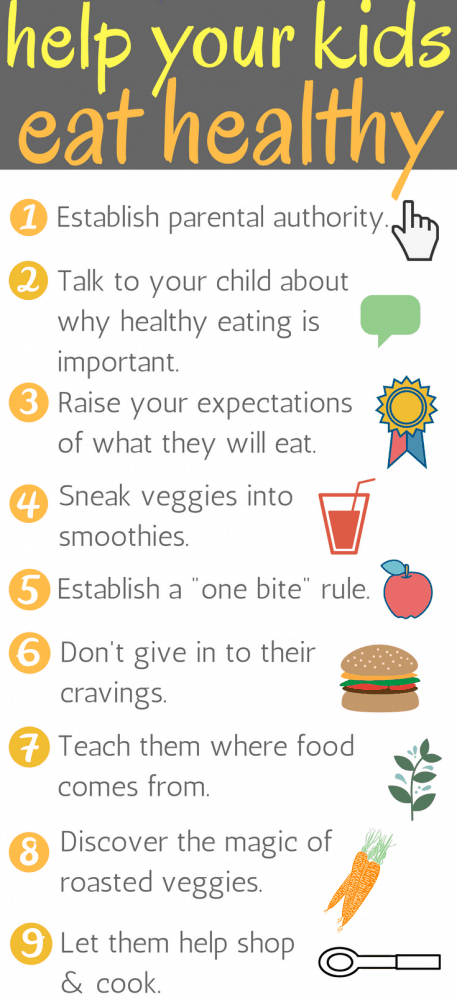Learning how to get kids to eat vegetables isn’t too hard, once you cultivate the right mindset. Changing your family culture to include wellness habits and education about healthy food will pique your child’s interest in a wide variety of foods. Once you establish some ground rules, new habits, and fun ideas, you’ll be well on your way to learning how to get kids to eat healthy. In this post, you’ll find out why healthy eating is so important to teach at an early age, and the nine best solutions for how to get kids to eat vegetables and healthy foods.
Maybe I’m lucky. On more than one occasion, people have commented as they observe my kids eating salad, vegetables, or casseroles, “Wow, your kids eat so well! How do you get them to eat all of those healthy foods?”
It takes me a minute to reply, mainly because it’s not something I have consciously tried to implement in my parenting. It just comes naturally to instill a love of nutritious food in my kids. This is all thanks to my mother, who instilled this love in me and knows all about how to get kids to eat vegetables.
But when I got to thinking about it, I realize there are several things that encourage children to love healthy eating. Maybe part of it is luck; maybe some kids just come out loving all different kinds of foods. But, I’m willing to guess that some definite molding of tastebuds also comes into play. By no means do my kids eat a perfect diet, but they will try just about anything and genuinely love many healthy foods.
Below, you’ll find out why healthy eating is so important to teach at an early age, and the best solutions for how to get kids to eat vegetables and healthy foods.
Setting Kids Up for Future Good Health and Happiness
Maybe you’re wondering, “Why is learning to eat healthy at a young age so important? Won’t my kid just grow into a love for healthy eating on their own?”
By encouraging your kids to eat a diverse selection of healthy foods while they are young, you are undoubtedly setting them up for a lifetime of better health. You’ll have fewer doctor visits and sick days. They will be able to succeed in all areas of their life because they will feel better, have more energy, and fewer health problems.
It’s sad to see that many childhood illnesses are on the rise, including diabetes, obesity and ADD/ADHD. All of this in an age when convenience foods are king. Read more in this article by Wellness Mama. A healthy diet is key for prevention and treatment for these conditions.
Not only will eating a diverse menu improve your child’s health, it will improve their happiness too. Healthy eating improves mood, and also enriches their life by allowing them to enjoy more foods they are unfamiliar with. If your children are used to trying new things as a child, they will be more likely to do the same as an adult.
I genuinely believe that instilling a love of healthy food and your children is one of the greatest gifts you can give them. Now that the benefits are clear, how do we actually get our child to learn to eat healthy foods?
(Before we jump into the tips, grab your free self-care rituals checklist!)
How to Get Kids to Eat Vegetables and Healthy Foods (9 Tips)
1. Realize you are the parent, and you get to decide.
There are lots of things we make our kids do whether they like it or not. Take baths, brush teeth, go to sleep early, talk respectfully, and share with others. Most of the time, these are considered non-negotiables – things that are just expected of our children. But for some reason, we sometimes make an exception when it comes to food.
I’m not sure why eating habits seem less important than other parenting issues, as we’ve just established how important nutrition is for growing bodies. Your child’s eating habits will start to change the day you decide that you are in charge and you know what is best for them. Once you have made up your mind that your child will be a healthy eater, you have already won half the battle.
Now, am I saying that this is easy? Of course not. Some children are naturally more picky than others, and my kids go through picky stages from time to time. But no matter how picky the child, they can still learn to eat a variety of healthy foods. It may be a difficult transition, just like any new disciplinary tactic is. It may take them some time to get used to a new way of eating. But in the end, it is more than worth it.
And as you help your child to transition into eating veggies, here is a goldmine of 50+ veggie recipes for vegetable haters and picky eaters! You’re sure to find some new favorites for your child here.
2. Explain the why.
Just this morning as we drank our fruit and veggie smoothie for breakfast, my oldest son took a couple sips and declared it “gross.” It contained celery, which is not something I usually put in our smoothie. Admittedly, celery is my least favorite vegetable too. But, I explained to my son that even though we don’t like something, we still need to eat it because our bodies need all kinds of different foods to be healthy and strong. I told him that I eat things on a regular basis that are not my favorite, but I eat them anyway because I know that my body needs them. This helped him to understand and take a few extra sips of the smoothie. When kids realize why they are doing something, they are a lot more likely to obey your instructions.
3. Raise your expectations.
If you don’t put something on your child’s plate because you know they won’t like it, essentially, you are judging them. Let me tell you a story that perfectly illustrates this point.
For an entire year, I put black or pinto beans on my kids’ plates as a side dish. They never wanted to touch the stuff, but I always made them try it. Then one day, almost like magic, my oldest decides that he loves black beans and he wants to eat some of mine, and then more, and more! Eventually he wanted to have his own bowl of beans. When his younger brother saw this, he also wanted to get in on the action. Now both of my boys willingly eat a bowl of beans at dinner time, something I never thought possible a year ago.
The point is, you may think your child doesn’t like something, but one day they will get used to it and realize how delicious it is. Don’t let them miss out on this exciting experience. Essentially, when you expect your child to eat something even if they don’t like it, eventually they will meet or even exceed your expectations.
4. Sneaky Smoothies.
Smoothies are also magical when it comes to getting your kids to eat healthy. Start with a base of fresh or frozen fruit, then add a handful of spinach or other raw veggie to up the nutrition factor. My favorite thing to do is add raw carrot to the fruit smoothie – you can’t taste it at all and it just adds sweetness. Other great additions to sneak in are coconut oil, flax or chia seeds, and yogurt/kefir. What kid doesn’t like a sweet, fruity smoothie?
This Blendtec is our all-time favorite blender for daily smoothies. It blends up everything into a silky smooth texture, even frozen chunks and crunchy carrots. It’s a great investment if you’re making smoothies regularly.
Related Post: “HULK” Green Smoothie
5. One bite (or more) rule.
This is something my mother instilled in me as a child, and I’m so grateful. At every meal there is a standing rule that everyone has to try at least one bite of everything on their plate. Everybody can try one bite, no matter how “gross” they think something is. Sometimes it’s more than one bite, depending on what their diet has been like that day. But nobody gets dessert or playtime until they try everything that is in front of them.
My mother ran a home day-care my entire childhood, and was often heard saying to the kids at mealtimes, “Everybody try everything!” She was often credited by parents with expanding their child’s tastes for healthy food. Most of the time, these parents previously thought their children were incapable of eating these healthy foods. It’s amazing what kids can do when given the opportunity.
6. Realize that giving in may seem easier, but it’s detrimental in the long run.
While serving your child chicken nuggets every night might seem like you are keeping the peace and dodging a tantrum, you are setting yourself (and them) up for pain in the future.
I’ve seen kids who refused to eat anything other than PB&J and Mac N’ Cheese. Risk of future health problems aside, can you see how difficult and boring this is making their life? Constantly having to search for food they like. Going hungry because what is served does not fit their criteria. Missing out on the incredible flavors this world has to offer while traveling. Not being able to relate with and socialize with people in the same way. Having a limited palate will have a huge detrimental effect on their every day life as an adult, and cause them to miss out on opportunities and experiences they love.
Here’s an example of how this scenario can play out. While living in Scotland, friends came to visit and some of our Scottish pals made a meal for them. Some of these Americans refused to eat the local food and would only eat the things they knew from home. It made me sad, because they missed out on some amazing cultural experiences. Don’t let this happen to your child!
7. Help them understand the source.
Letting your child learn about where food comes from often begins a spark of interest in new foods. Choose a veggie or two to plant in your yard and see what happens! This past summer our boys had a blast helping plant and dig up potatoes. They ate and loved every bite of the roasted potatoes they helped to grow.
8. Roasted vegetable magic.
I don’t know what it is, but roasting veggies in the oven ALWAYS makes them taste amazing. Even vegetables I don’t particularly like taste as good as candy when they’re roasted! Just slice/chop the veggies of your choice, spread on a sheet pan in an even layer, drizzle with olive oil, salt, and pepper, and roast at 400° F until soft and golden brown/caramelized. I promise, your kids will devour them.
9. Let them help shop/cook.
Get your kids involved in the food preparation process, which is another great way to expand their palate. When a child has helps create something, they are much more inclined to give it a try. Let them pick out some new veggies at the market and put items onto the conveyor belt. Spend time with them in the kitchen and let them help stir, pour, etc. They will love the process and it gives them a great education on how food gets on their plate.
Pin for later:
Teaching kids how to enjoy healthy foods can be fun. It may be an adjustment, but with a little time and perseverance, your can also get kids to eat vegetables (and other “yucky” things)!
Comment below: do you have any other tips on how to get kids to eat vegetables?
With Joy,









Leave a Reply